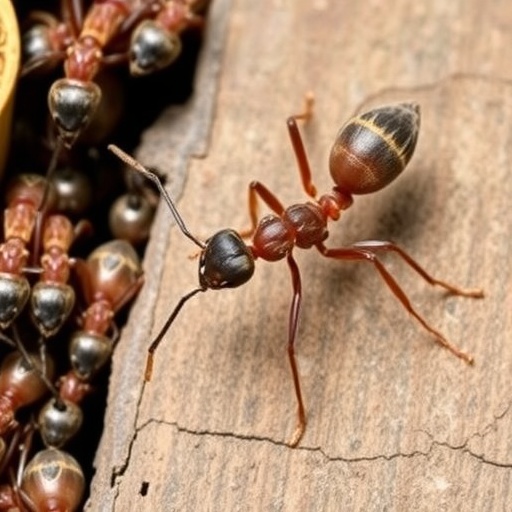In the intricate world of animal behavior, wound care has long been recognized as a critical survival mechanism, extending far beyond human and mammalian species. Recent findings reveal that the humble carpenter ant, Camponotus maculatus, adopts a drastic yet highly effective strategy to combat infections stemming from injuries: amputation. This groundbreaking discovery sheds light on the sophisticated and pragmatic approaches to health within insect societies.
Researchers at Julius-Maximilians-Universität Würzburg (JMU) have uncovered that carpenter ants often opt to amputate injured limbs at the base—near the shoulder—using their formidable mandibles. This behavior occurs irrespective of whether the wound appears infected, highlighting an evolutionary inclination towards a preventive approach rather than reactive treatment. Amputating a limb might seem extreme, but for these ants, it is a calculated prophylactic measure that significantly enhances survival chances by halting the progression of potential infections.
Erik Frank, the lead biologist spearheading this research, alongside his team, conducted detailed observational studies to understand the decision-making criteria ants use when choosing amputation. Unlike mammals or even some insect species that utilize antimicrobial secretions to inhibit infection, carpenter ants demonstrate a preference for removing the source of possible infection altogether. This approach mimics certain principles found in human medicine, where amputation has historically been a critical intervention to prevent systemic infection.
From a biomechanical standpoint, the capacity of worker ants to swiftly amputate limbs within their densely populated colonies is remarkable. The strength and precision of their mandibles allow them to perform clean breaks at the correct anatomical position, which minimizes trauma and prevents further harm. This response occurs rapidly after injury, underscoring an evolved reflex within ant social behavior to prioritize colony health over the preservation of individual limbs.
The implications of this research extend beyond the behavioral biology of ants. By demonstrating that prophylactic amputation can double the survival rates of injured workers, the study challenges conventional perceptions of insect injury management and opens new investigative avenues into evolutionary adaptations for infection control. Notably, the inability of ants to wait for clear signs of infection before intervening suggests a highly risk-averse strategy shaped by the pressures of living in large, communal environments.
Living in close quarters exposes ants to rapid transmission of pathogens, making prompt and decisive wound treatment essential for colony fitness. Whereas some social insects produce antimicrobial compounds or even engage in social grooming to minimize infection, Camponotus maculatus employs amputation as a stark but efficient alternative. This contrasts with related species that rely more heavily on chemical treatments, hinting at diverse evolutionary pathways within the Formicidae family regarding injury management.
The decision-making process underlying this amputative behavior presents a fascinating parallel to human clinical judgement. In both cases, practitioners must weigh the risks of intervention against potential outcomes, often erring on the side of caution when faced with uncertain infection status. This comparison illustrates how even insects with relatively simple nervous systems have evolved complex behavioral repertoires that optimize survival through risk management and proactive medical-like interventions.
Future research, as indicated by doctoral candidate Seiji Fujimoto, aims to delve deeper into the comparative evolution of wound care strategies across ant species. Understanding why only some species resort to amputation while others employ antimicrobial secretions could reveal fundamental principles about the adaptive trade-offs between physical sacrifice and chemical defense. Such studies promise to enrich our comprehension of social insect ecology and evolutionary biology.
Moreover, these insights may inspire novel biomimetic applications in medicine and robotics, where rapid, decisive responses to injury or damage could enhance system reliability. The carpenter ant’s approach exemplifies how natural systems optimize outcomes through seemingly harsh but strategically sound measures, a lesson that transcends the boundaries of entomology into broader biological and applied sciences.
Attention to detail in observing how ants identify injured individuals, assess the severity of wounds, and execute amputation swiftly has also contributed to our knowledge of insect communication and social coordination. It is likely that chemical signaling or tactile cues prompt the collective behavior seen in treating injured nestmates, pointing to an intricate neural and chemical infrastructure supporting these life-saving actions.
This research not only underscores the importance of preventive care within natural systems but also challenges the scientific community to reconsider assumptions about the sophistication of insect health management. The carpenter ant’s leg amputation behavior stands as a remarkable testament to nature’s ingenuity in confronting the perennial challenge of infection and injury in environments of intense social interaction.
Ultimately, the study titled “Better Safe Than Sorry: Leg Amputations as a Prophylactic Wound Care Behaviour in Carpenter Ants” opens a compelling chapter in ethology and microbiology, revealing that even the smallest creatures employ strategies echoing human medical logic. As this field evolves, it promises to broaden our horizons on the convergence of behavioral ecology, evolutionary medicine, and the intelligent adaptation of survival tactics in the animal kingdom.
Subject of Research: Animals
Article Title: Better Safe Than Sorry: Leg Amputations as a Prophylactic Wound Care Behaviour in Carpenter Ants
News Publication Date: 22-Oct-2025
Web References: http://dx.doi.org/10.1098/rspb.2025.1688
Image Credits: Bart Zijlstra
Keywords: carpenter ants, wound care, amputation, infection control, prophylactic behavior, social insects, Camponotus maculatus, behavioral ecology, evolutionary biology, antimicrobial defense, animal behavior, ethology




